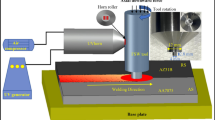Abstract
The method proposed in this study is to determine the welding sequence to suppress welding de-formation using the strain directed as boundary (SDB) method. Welded joints are modeled by constructing tack welds and gaps as kinematic constraints in shell models. In addition, the SDB method considering the elastoplastic properties is used to evaluate the effect on the previous welding procedure. The results of the constructed analysis model are compared with the experimental results. The residual strain of each weld is calculated using the verified model, and joint stiffness is determined and compared by considering this together with the relationship between tensile stress and shrinkage strain of the weld. The optimal welding sequence is determined by comparing the stiffness of each welding joint, and this is compared and verified with the experimental results. In addition, it is confirmed that the determined welding sequence reduced the out-of-plane deformation by 2.01 % compared to the original welding sequence. The proposed method thus provides an analytical approach for welding sequence design.
Similar content being viewed by others
References
Y. Ueda and T. Yamakawa, Analysis of thermal elastic-plastic stress and strain during welding by finite element method, Trans. JWRI., 2(2) (1971) 90–100.
S. Okano and M. Mochizuki, Transient distortion behavior during TIG welding of thin steel plate, J. Mater. Process. Technol., 241 (2017) 103–111.
D. Venkatkumar and D. Ravindran, 3D finite element simulation of temperature distribution, residual stress and distortion on 304 stainless steel plates using GTA welding, Journal of Mechanical Science and Technology, 30(1) (2016) 67–76.
R. Keivani, B. Bagheri, F. Sharifi, M. Ketabchi and M. Abbasi, Effects of pin angle and preheating on temperature distribution during friction stir welding operation, Transactions of Nonferrous Metals Society of China, 23(9) (2013) 2708–2713.
M. Abbasi, B. Bagheri and R. Keivani, Thermal analysis of friction stir welding process and investigation into affective parameters using simulation, Journal of Mechanical Science and Technology, 29(2) (2015) 861–866.
B. Bagheri, A. Abdollahzadeh, M. Abasi and A. H. Kokabi, Numerical analysis of vibration effect on friction stir welding by smoothed particle hydrodynamics (SPH), The International Journal of Advanced Manufacturing Technology, 110(1) (2020) 209–228.
B. Behrouz, M. Abbasi, A. Abdollahzadeh and A. H. Kokabi, Numerical analysis of cooling and joining speed effects on friction stir welding by smoothed particle hydrodynamics (SPH), Archive of Applied Mechanics, 90(10) (2020) 2275–2296.
H. Murakawa, D. Deng, S. Rashed and S. Sato, Prediction of distortion produced on welded structures during assembly using inherent deformation and interface element, Transactions of JWRI, 38(2) (2009) 63–69.
J. Wang, S. Rashed and H. Murakawa, Mechanism investigation of welding induced buckling using inherent deformation method, Thin-Walled Structures, 80 (2014) 103–119.
Y. S. Ha, Development of thermal distortion analysis method on large shell structure using inherent strain as boundary condition, J. Soc. Nav. Archit. Korea, 45 (2008) 93–100.
Y. S. Ha, Analytical methodology obtaining an optimal welding sequence for least distortion of welded structure, J. Welding an Joining, 31(3) (2013) 54–59.
Y. H. Duan, Y. Vincent, F. Boitout, J. B. Leblond and J. M. Bergheau, Prediction of welding residual distortions of large structures using a local/global approach, Journal of Mechanical Science and Technology, 21(10) (2007) 1700–1706.
K. Masubuchi, Y. Ogura, Y. Ishihara and J. Hoshino, Studies on the mechanism of the origin and the method of reducing the deformation of shell plating in welded ships, International Shipbuilding Progress, 3(19) (1956) 123–133.
S. C. Park, Distortion mechanisms and control methodology for welding thin plate panel structures, Ph.D. Dissertation, The Ohio State University, USA (1998).
J. U. Park and G. B. An, Effect of welding sequence to minimize fillet welding distortion in a ship’s small component fabrication using joint rigidity method, Proc. Inst. Mech. Eng. B: J. Eng. Manuf., 230 (2016) 643–653.
Author information
Authors and Affiliations
Corresponding author
Additional information
Hong Jun Noh is a Ph.D. Candidate in Mechanical Engineering at Hanyang University. His research interests are in welding, thermal deformation, manufacturing process.
Hee Chan Yoon is a Ph.D. Candidate in Mechanical Engineering at Hanyang University. His research interest is welding, thermal deformation.
Hun Bong Lim is a Professor of Mechanical Engineering at Myongji College. His research interests are in mechanical design.
Hyun Ik Yang is a Professor of Mechanical Engineering at Hanyang University. His research interests are in mechanical design and optimization, offshore structure design, welding process optimization and hydrothermal polymerization.
Rights and permissions
About this article
Cite this article
Noh, HJ., Yoon, HC., Lim, HB. et al. Welding sequence optimization using the strain direct boundary method based on the welding induced change in structural stiffness. J Mech Sci Technol 36, 6193–6199 (2022). https://doi.org/10.1007/s12206-022-1133-3
Received:
Revised:
Accepted:
Published:
Issue Date:
DOI: https://doi.org/10.1007/s12206-022-1133-3




